engine GMC ENVOY 2009 Owner's Guide
[x] Cancel search | Manufacturer: GMC, Model Year: 2009, Model line: ENVOY, Model: GMC ENVOY 2009Pages: 474, PDF Size: 2.56 MB
Page 113 of 474
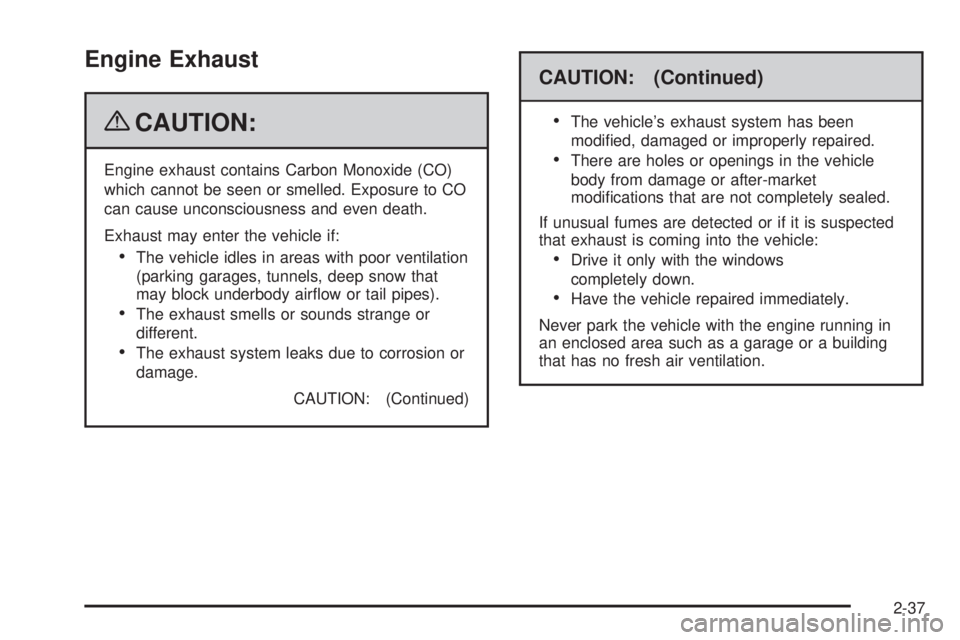
Engine Exhaust
{CAUTION:
Engine exhaust contains Carbon Monoxide (CO)
which cannot be seen or smelled. Exposure to CO
can cause unconsciousness and even death.
Exhaust may enter the vehicle if:
The vehicle idles in areas with poor ventilation
(parking garages, tunnels, deep snow that
may block underbody air�ow or tail pipes).
The exhaust smells or sounds strange or
different.
The exhaust system leaks due to corrosion or
damage.
CAUTION: (Continued)
CAUTION: (Continued)
The vehicle’s exhaust system has been
modi�ed, damaged or improperly repaired.
There are holes or openings in the vehicle
body from damage or after-market
modi�cations that are not completely sealed.
If unusual fumes are detected or if it is suspected
that exhaust is coming into the vehicle:
Drive it only with the windows
completely down.
Have the vehicle repaired immediately.
Never park the vehicle with the engine running in
an enclosed area such as a garage or a building
that has no fresh air ventilation.
2-37
Page 114 of 474
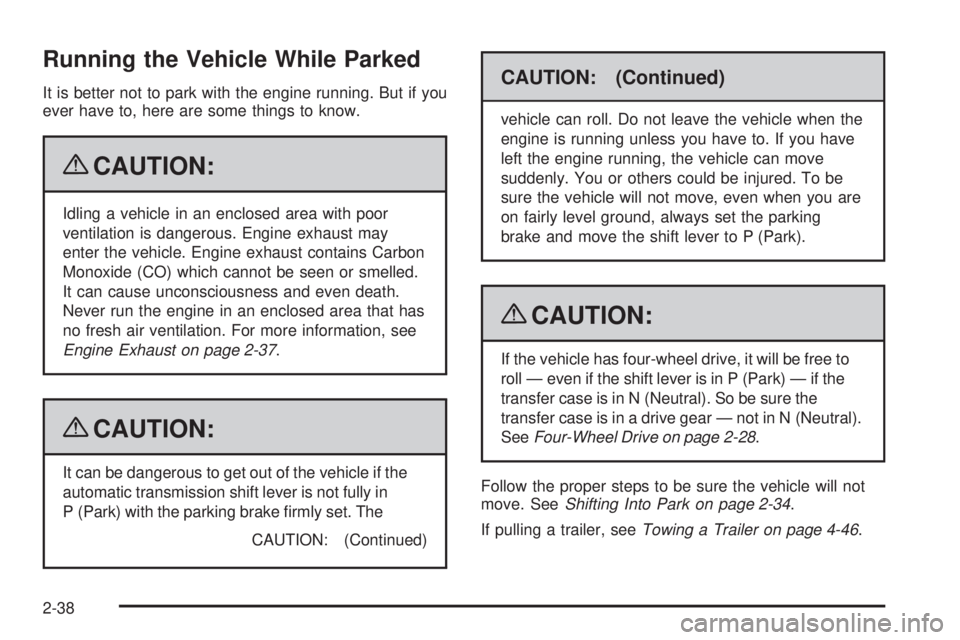
Running the Vehicle While Parked
It is better not to park with the engine running. But if you
ever have to, here are some things to know.
{CAUTION:
Idling a vehicle in an enclosed area with poor
ventilation is dangerous. Engine exhaust may
enter the vehicle. Engine exhaust contains Carbon
Monoxide (CO) which cannot be seen or smelled.
It can cause unconsciousness and even death.
Never run the engine in an enclosed area that has
no fresh air ventilation. For more information, see
Engine Exhaust on page 2-37.
{CAUTION:
It can be dangerous to get out of the vehicle if the
automatic transmission shift lever is not fully in
P (Park) with the parking brake �rmly set. The
CAUTION: (Continued)
CAUTION: (Continued)
vehicle can roll. Do not leave the vehicle when the
engine is running unless you have to. If you have
left the engine running, the vehicle can move
suddenly. You or others could be injured. To be
sure the vehicle will not move, even when you are
on fairly level ground, always set the parking
brake and move the shift lever to P (Park).
{CAUTION:
If the vehicle has four-wheel drive, it will be free to
roll — even if the shift lever is in P (Park) — if the
transfer case is in N (Neutral). So be sure the
transfer case is in a drive gear — not in N (Neutral).
SeeFour-Wheel Drive on page 2-28.
Follow the proper steps to be sure the vehicle will not
move. SeeShifting Into Park on page 2-34.
If pulling a trailer, seeTowing a Trailer on page 4-46.
2-38
Page 134 of 474

Brake System Warning Light..........................3-35
Antilock Brake System (ABS) Warning Light.....3-36
StabiliTrak
®Service Light...............................3-36
StabiliTrak®Indicator Light.............................3-37
Engine Coolant Temperature Gage..................3-37
Tire Pressure Light.......................................3-38
Malfunction Indicator Lamp.............................3-38
Oil Pressure Gage........................................3-42
Change Engine Oil Light................................3-43
Security Light...............................................3-43
Cruise Control Light......................................3-43
Reduced Engine Power Light.........................3-44
Highbeam On Light.......................................3-44
Service Four-Wheel Drive Warning Light..........3-44
Check Gages Warning Light...........................3-45
Gate Ajar Light.............................................3-45
Fuel Gage...................................................3-46
Low Fuel Warning Light.................................3-47
Check Gas Cap Light....................................3-47Driver Information Center (DIC).......................3-47
DIC Operation and Displays...........................3-48
DIC Warnings and Messages.........................3-51
DIC Vehicle Customization.............................3-56
Audio System(s).............................................3-62
Setting the Clock..........................................3-63
Radio(s)......................................................3-64
Using an MP3..............................................3-80
XM Radio Messages.....................................3-84
Navigation/Radio System...............................3-86
Bluetooth
®...................................................3-86
Rear Seat Entertainment (RSE) System...........3-96
Rear Seat Audio (RSA)................................3-109
Theft-Deterrent Feature................................3-110
Audio Steering Wheel Controls......................3-110
Radio Reception.........................................3-111
Fixed Mast Antenna....................................3-112
XM™ Satellite Radio Antenna System............3-112
Chime Level Adjustment...............................3-112
Section 3 Instrument Panel
3-2
Page 149 of 474
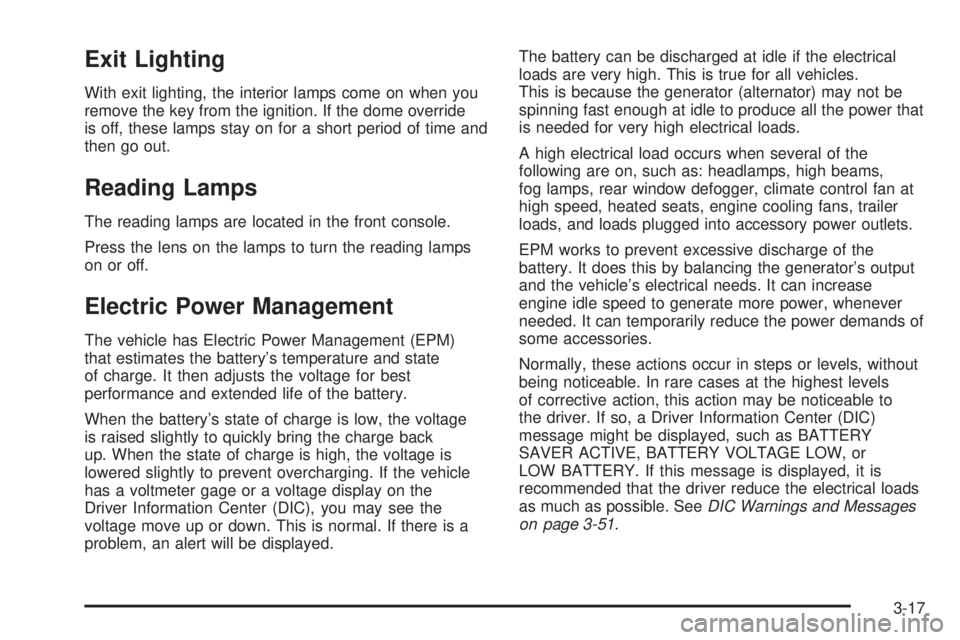
Exit Lighting
With exit lighting, the interior lamps come on when you
remove the key from the ignition. If the dome override
is off, these lamps stay on for a short period of time and
then go out.
Reading Lamps
The reading lamps are located in the front console.
Press the lens on the lamps to turn the reading lamps
on or off.
Electric Power Management
The vehicle has Electric Power Management (EPM)
that estimates the battery’s temperature and state
of charge. It then adjusts the voltage for best
performance and extended life of the battery.
When the battery’s state of charge is low, the voltage
is raised slightly to quickly bring the charge back
up. When the state of charge is high, the voltage is
lowered slightly to prevent overcharging. If the vehicle
has a voltmeter gage or a voltage display on the
Driver Information Center (DIC), you may see the
voltage move up or down. This is normal. If there is a
problem, an alert will be displayed.The battery can be discharged at idle if the electrical
loads are very high. This is true for all vehicles.
This is because the generator (alternator) may not be
spinning fast enough at idle to produce all the power that
is needed for very high electrical loads.
A high electrical load occurs when several of the
following are on, such as: headlamps, high beams,
fog lamps, rear window defogger, climate control fan at
high speed, heated seats, engine cooling fans, trailer
loads, and loads plugged into accessory power outlets.
EPM works to prevent excessive discharge of the
battery. It does this by balancing the generator’s output
and the vehicle’s electrical needs. It can increase
engine idle speed to generate more power, whenever
needed. It can temporarily reduce the power demands of
some accessories.
Normally, these actions occur in steps or levels, without
being noticeable. In rare cases at the highest levels
of corrective action, this action may be noticeable to
the driver. If so, a Driver Information Center (DIC)
message might be displayed, such as BATTERY
SAVER ACTIVE, BATTERY VOLTAGE LOW, or
LOW BATTERY. If this message is displayed, it is
recommended that the driver reduce the electrical loads
as much as possible. SeeDIC Warnings and Messages
on page 3-51.
3-17
Page 152 of 474

Driver’s Side Temperature Lever:Raise or lower the
lever to increase or decrease the temperature on
the driver’s side of the vehicle.
Passenger Side Temperature Lever:Raise or lower
the lever to increase or decrease the temperature on the
passenger side of the vehicle. This right lever also
adjusts the temperature to the rear seat outlets.
When the temperature outside is 0°F (-18°C) or lower,
use the engine coolant heater, if the vehicle has one,
to provide warmer air faster to the vehicle.
9(Fan Control):Turn clockwise or counterclockwise
to increase or decrease the fan speed. If the knob
is in off mode, outside air still enters the vehicle, and is
directed based on the position of the air delivery
mode knob. The temperature can still be adjusted using
the temperature knob.
Air Delivery Mode Control:Turn clockwise or
counterclockwise to change the air�ow direction inside
the vehicle.To change the current mode, select one of the following:
H(Vent):Air is directed to the instrument panel
outlets.
)(Bi-Level):Air is divided between the instrument
panel and �oor outlets. Some air is directed toward the
windshield and the side window outlets. Cooler air is
directed to the upper vents and warmer air to the �oor
outlets.
6(Floor):Air is directed to the �oor outlets, with
some air directed to the windshield and the side window
outlets. The recirculation button cannot be selected
while in �oor mode.
-(Defog):This mode clears the windows of fog or
moisture. Air is directed to the �oor, windshield and side
window outlets. The recirculation button cannot be
selected while in defog mode.
1(Defrost):This mode clears the windows of fog or
frost more quickly. Air is directed to the windshield
and the side window outlets, with some air directed to
the �oor outlets. The air conditioning compressor
3-20
Page 153 of 474
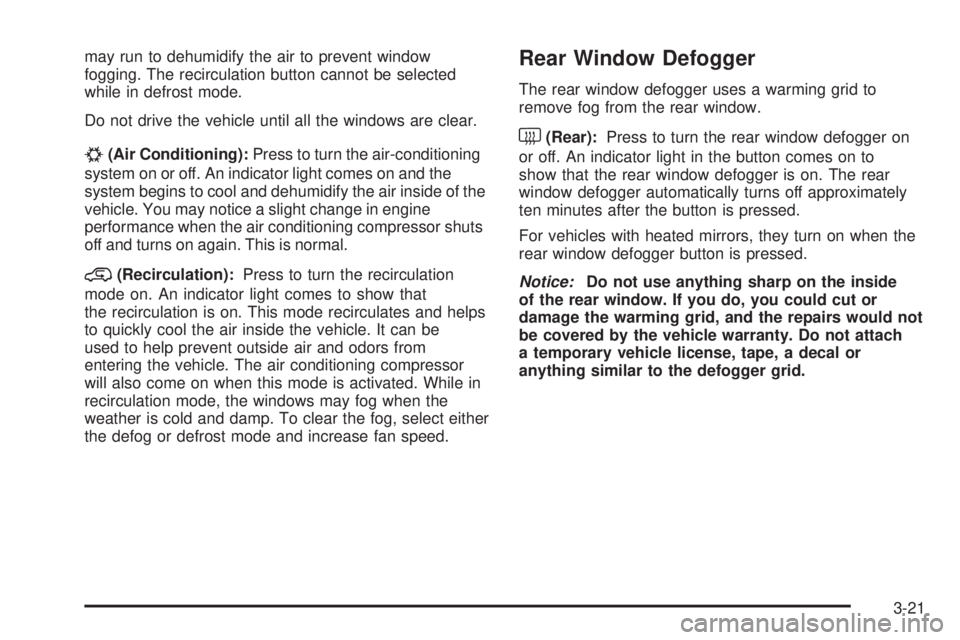
may run to dehumidify the air to prevent window
fogging. The recirculation button cannot be selected
while in defrost mode.
Do not drive the vehicle until all the windows are clear.
#(Air Conditioning):Press to turn the air-conditioning
system on or off. An indicator light comes on and the
system begins to cool and dehumidify the air inside of the
vehicle. You may notice a slight change in engine
performance when the air conditioning compressor shuts
off and turns on again. This is normal.
@(Recirculation):Press to turn the recirculation
mode on. An indicator light comes to show that
the recirculation is on. This mode recirculates and helps
to quickly cool the air inside the vehicle. It can be
used to help prevent outside air and odors from
entering the vehicle. The air conditioning compressor
will also come on when this mode is activated. While in
recirculation mode, the windows may fog when the
weather is cold and damp. To clear the fog, select either
the defog or defrost mode and increase fan speed.
Rear Window Defogger
The rear window defogger uses a warming grid to
remove fog from the rear window.
<(Rear):Press to turn the rear window defogger on
or off. An indicator light in the button comes on to
show that the rear window defogger is on. The rear
window defogger automatically turns off approximately
ten minutes after the button is pressed.
For vehicles with heated mirrors, they turn on when the
rear window defogger button is pressed.
Notice:Do not use anything sharp on the inside
of the rear window. If you do, you could cut or
damage the warming grid, and the repairs would not
be covered by the vehicle warranty. Do not attach
a temporary vehicle license, tape, a decal or
anything similar to the defogger grid.
3-21
Page 154 of 474

Dual Automatic Climate Control
System
With this system the heating, cooling and ventilation can
be controlled on the vehicle. When the vehicle is �rst
started and the climate control system is on, or if
the climate control system has been turned on, the
display shows the driver’s temperature setting for
�ve seconds. Then it shows the outside temperature.
A. Driver and Passenger
Side Temperature
Controls
B. Fan Control
C. Display
D. AUTO
E. Power ButtonF. Recirculation
G. Air Conditioning
H. Defrost
I. Air Delivery Mode
Control
J. Rear Window
Defogger
Outside Air Temperature Display
A new outside temperature reading is displayed if
the vehicle has been off for more than three hours.
If the vehicle has been off for less than three hours,
the old temperature reading may be displayed because
underhood heat is affecting the true outside temperature.
Underhood heat can also affect the outside temperature
while the engine is running. It may also take several
minutes of driving before the display updates to
the actual outside temperature.
Automatic Operation
AUTO (Automatic):When automatic operation is
active, the system controls the air delivery mode,
fan speed, and temperature inside the vehicle.
Use the steps below to place the entire system in
automatic mode:
1. Press AUTO.
When AUTO is selected, the air conditioning
and air inlet are automatically controlled. The air
conditioning compressor will run continuously when
the outside temperature is over approximately
40°F (4°C). The air inlet will normally be set
to outside air. If it is hot outside, the air inlet
automatically changes to recirculate inside air to
help quickly cool down the vehicle.
3-22
Page 156 of 474

To change the current air delivery mode, select one of
the following:
H(Vent):Air is directed to the instrument panel outlets.
)(Bi-Level):Air is divided between the instrument
panel and �oor outlets. Some air is directed toward the
windshield and side window outlets. Cooler air is
directed to the upper outlets and warmer air to the �oor
outlets.
6(Floor):Air is directed to the �oor outlets. Some air
also comes out of the defroster and side window
outlets. The recirculation button cannot be selected in
�oor mode.
-(Defog):This mode clears the windows of fog or
moisture. Air is directed to the �oor and windshield
outlets.
0(Front Defrost):Press the front defrost button to
clear the windows of fog or frost more quickly. The
system automatically controls the fan speed if defrost is
selected from AUTO mode. If the outside temperature
is 40°F (4°C) or warmer, the air conditioning compressor
runs automatically to help dehumidify the air and dry
the windshield.
Do not drive the vehicle until all the windows are clear.
#A/C (Air Conditioning):Press to turn the air
conditioning system on or off. When the system is on,
the system automatically begins to cool and dehumidify
the air inside of the vehicle. The air conditioning
symbol appears on the display when the air conditioning
is on and turns off when the air conditioning is off.
If the air conditioning is turned off while in front defrost
or defog mode, the air conditioning symbol turns off,
however, the A/C compressor remains on to help
de-humidify the air inside the vehicle. If one of the other
modes is selected, the compressor will then turn the
A/C off until it is selected again or the AUTO button is
pressed.
To avoid fogging the inside glass on rainy and humid
days at a temperature above freezing, press the
air conditioning button to run the A/C compressor.
Also it is best to avoid the use of the recirculation mode
except when maximum air conditioning performance
is needed or for short times to avoid exterior odors.
You may notice a slight change in engine performance
when the air-conditioning compressor shuts off and
turns on again. This is normal.
3-24
Page 157 of 474
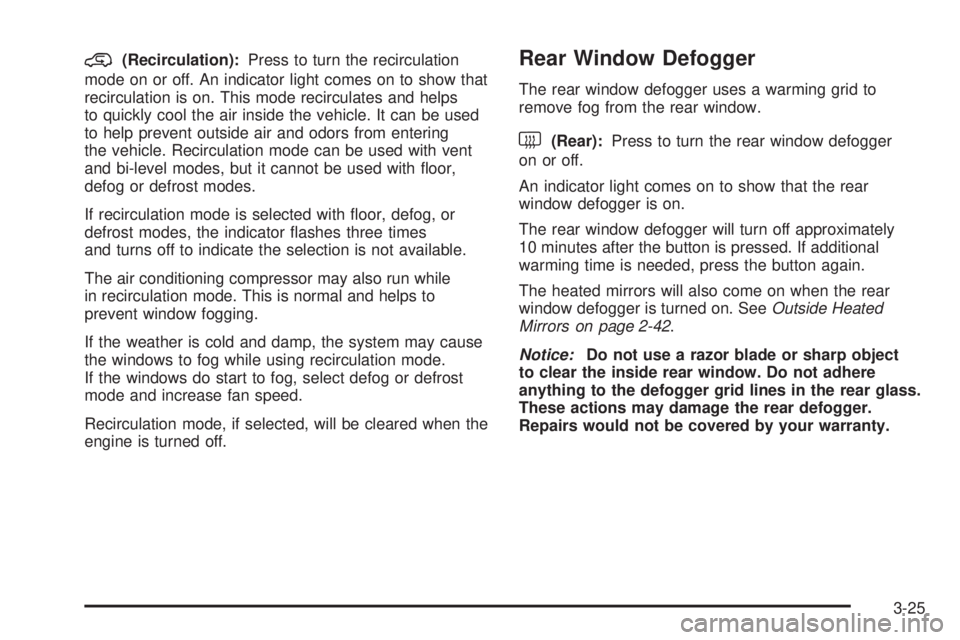
@(Recirculation):Press to turn the recirculation
mode on or off. An indicator light comes on to show that
recirculation is on. This mode recirculates and helps
to quickly cool the air inside the vehicle. It can be used
to help prevent outside air and odors from entering
the vehicle. Recirculation mode can be used with vent
and bi-level modes, but it cannot be used with �oor,
defog or defrost modes.
If recirculation mode is selected with �oor, defog, or
defrost modes, the indicator �ashes three times
and turns off to indicate the selection is not available.
The air conditioning compressor may also run while
in recirculation mode. This is normal and helps to
prevent window fogging.
If the weather is cold and damp, the system may cause
the windows to fog while using recirculation mode.
If the windows do start to fog, select defog or defrost
mode and increase fan speed.
Recirculation mode, if selected, will be cleared when the
engine is turned off.Rear Window Defogger
The rear window defogger uses a warming grid to
remove fog from the rear window.
<(Rear):Press to turn the rear window defogger
on or off.
An indicator light comes on to show that the rear
window defogger is on.
The rear window defogger will turn off approximately
10 minutes after the button is pressed. If additional
warming time is needed, press the button again.
The heated mirrors will also come on when the rear
window defogger is turned on. SeeOutside Heated
Mirrors on page 2-42.
Notice:Do not use a razor blade or sharp object
to clear the inside rear window. Do not adhere
anything to the defogger grid lines in the rear glass.
These actions may damage the rear defogger.
Repairs would not be covered by your warranty.
3-25
Page 159 of 474

A. Fan Control
B. Power Button
C. Air Delivery Mode Control
If the vehicle has the rear seat audio system, the lower
buttons are used to adjust the rear seat climate
control system. The temperature of the air coming
through the rear outlets is determined by the front
passenger temperature setting.
P(On/Off):Press to turn the rear climate controls on
or off.
z9y(Fan Control):Press to increase or decrease
the fan speed.
z\y(Air Delivery Mode Control):Press to
change the direction of air�ow (panel, bi-level or �oor)
to the rear seat area.
The rear control only turns on if the front climate control
system is on and not in defrost mode.
Warning Lights, Gages, and
Indicators
Warning lights and gages can signal that something is
wrong before it becomes serious enough to cause
an expensive repair or replacement. Paying attention to
the warning lights and gages could prevent injury.
Warning lights come on when there may be or is a
problem with one of the vehicle’s functions. Some
warning lights come on brie�y when the engine is started
to indicate they are working.
Gages can indicate when there may be or is a problem
with one of the vehicle’s functions. Often gages and
warning lights work together to indicate a problem with
the vehicle.
When one of the warning lights comes on and stays on
while driving, or when one of the gages shows there
may be a problem, check the section that explains
what to do. Follow this manual’s advice. Waiting to do
repairs can be costly and even dangerous.
3-27